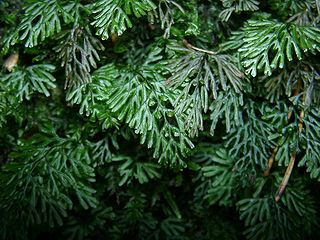
The Hymenophyllaceae, the filmy ferns and bristle ferns, are a family of two to nine genera and about 650 known species of ferns, with a subcosmopolitan distribution, but generally restricted to very damp places or to locations where they are wetted by spray from waterfalls or springs. A recent fossil find shows that ferns of Hymenophyllaceae have existed since at least the Upper Triassic.

Lastreopsis, known as shieldfern, is a genus of ferns in the family Dryopteridaceae, subfamily Elaphoglossoideae, in the Pteridophyte Phylogeny Group classification of 2016.
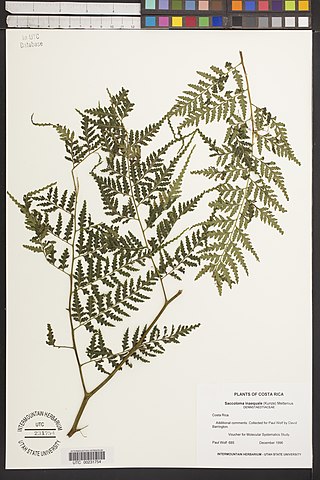
Saccoloma is a fern genus in family Saccolomataceae. It is the only genus in the family in the Pteridophyte Phylogeny Group classification of 2016, but further investigation is needed. It is pantropical and its species are found in wet, shaded forest areas. Saccoloma species are characterized by an omega-shaped (Ω) vascular bundle in the cross-sections of their petioles. The common name soralpouch fern is used for Saccoloma.

Thelypteris is a genus of ferns in the subfamily Thelypteridoideae, family Thelypteridaceae, order Polypodiales. Two radically different circumscriptions of the genus are in use as of January 2020. In the Pteridophyte Phylogeny Group classification of 2016, the genus is a very small one with about two species. In other approaches, the genus is the only one in the subfamily Thelypteridoideae, and so includes between 875 and 1083 species.

Polyphlebium angustatum is a species of fern in the family Hymenophyllaceae. It is found in South America and on a number of Atlantic islands, including Tristan da Cunha. The genus Polyphlebium is accepted in the Pteridophyte Phylogeny Group classification of 2016 (PPG I), but not by other sources. As of October 2019, Plants of the World Online sank the genus into a broadly defined Trichomanes, treating this species as Trichomanes angustatum.
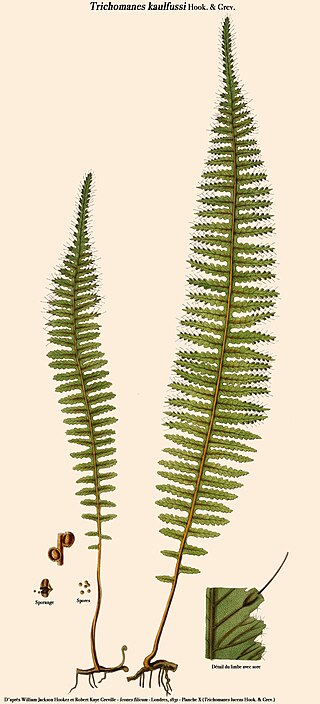
Trichomanes is a genus of ferns in the family Hymenophyllaceae, termed bristle ferns. The circumscription of the genus is disputed. All ferns in the genus are filmy ferns, with leaf tissue typically 2 cells thick. This thinness generally necessitates a permanently humid habitat, and makes the fronds somewhat translucent. Because of this membrane-like frond tissue, the plant is prone to drying out. “Filmy ferns” in the taxa Hymenophyllaceae grow in constantly wet environments. Many are found in cloud forests such as “Choco” in Colombia. There are also members of the taxa that can grow submersed in water.
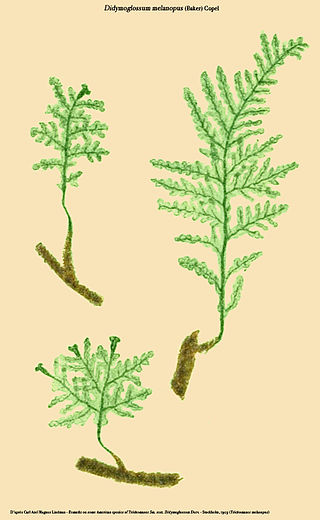
Didymoglossum melanopus is a species of fern in the family Hymenophyllaceae. It is endemic to Ecuador.

Microgramma is a genus of ferns in the family Polypodiaceae, subfamily Polypodioideae, according to the Pteridophyte Phylogeny Group classification of 2016 (PPG I). They are commonly known as vine ferns or snakeferns.
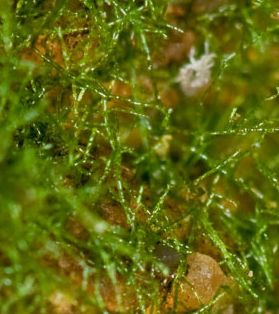
Crepidomanes intricatum, synonym Trichomanes intricatum, is known as the weft fern. The genus Crepidomanes is accepted in the Pteridophyte Phylogeny Group classification of 2016, but not by some other sources. As of October 2019, Plants of the World Online sank the genus into a broadly defined Trichomanes, treating this species as Trichomanes intricatum.

Palhinhaea cernua, synonym Lycopodiella cernua and Lycopodium cernuum, is a plant in the family Lycopodiaceae, commonly known as the staghorn clubmoss. The Hawaiian name for the plant is wāwaeʻiole, or "rat's foot". It has a substantial number of scientific synonyms in several genera. The genus Palhinhaea is accepted in the Pteridophyte Phylogeny Group classification of 2016, but not in other classifications which submerge the genus in Lycopodiella. It is the largest of the clubmosses, having rhizomes up to 5 m (16 ft) in length, with leafy uprights up to 2.5 m in height.
Hemidictyum is a genus of ferns with a single species, Hemidictyum marginatum, commonly known as the marginated half net fern. In the Pteridophyte Phylogeny Group classification of 2016, it is the only genus in the family Hemidictyaceae. Alternatively, the family, along with Aspleniaceae sensu stricto, may be placed in a much more broadly defined family Aspleniaceae as the subfamily Asplenioideae.
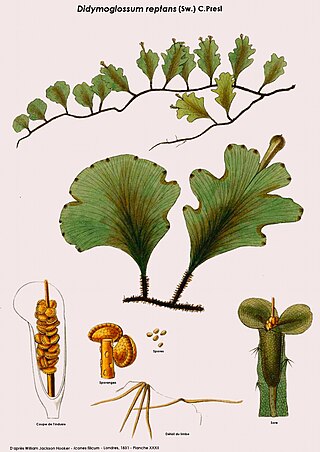
Didymoglossum is a tropical genus of ferns in the family Hymenophyllaceae. It comprises more than 30 epilithic or low-epiphytic species under two subgenera. The genus is accepted in the Pteridophyte Phylogeny Group classification of 2016, but not by some other sources which sink it into a broadly defined Trichomanes.

Cephalomanes is a fern genus in the family Hymenophyllaceae. The genus is accepted in the Pteridophyte Phylogeny Group classification of 2016 but not by other sources, which sink it into a broadly defined Trichomanes.
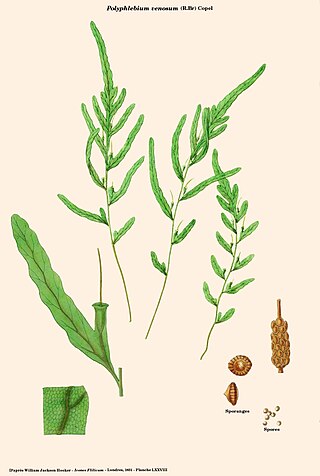
Polyphlebium venosum, the veined bristle-fern or bristle filmy fern, is a fern in the family Hymenophyllaceae. It is only found in wet forests, mainly growing as an epiphyte on the shady side of the soft tree fern, Dicksonia antarctica. It also grows on logs, trunks of trees and rarely on trunks of Cyathea species or on wet rock-faces. It is found in the wetter parts of Eastern Australia and New Zealand. P. venosum has poor long-distance dispersal compared to other ferns due to its short lived spore. Notable features of Polyphlebium venosum include it being one cell layer thick, 5–15 cm in length, having many branching veins and a trumpet shaped indusium.

Callistopteris is a fern genus in the family Hymenophyllaceae. The genus is accepted in the Pteridophyte Phylogeny Group classification of 2016 but not by some other sources, which sink it into a broadly defined Trichomanes.

Polyphlebium is a fern genus in the family Hymenophyllaceae. The genus is accepted in the Pteridophyte Phylogeny Group classification of 2016 but not by some other sources.

Vandenboschia is a fern genus in the family Hymenophyllaceae. The genus is accepted in the Pteridophyte Phylogeny Group classification of 2016 but not by some other sources.
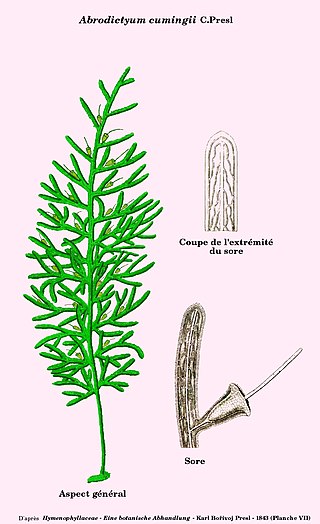
Abrodictyum is a fern genus in the family Hymenophyllaceae. The genus is accepted in the Pteridophyte Phylogeny Group classification of 2016 but not by some other sources, which sink it into a broadly defined Trichomanes.

Cephalomanes atrovirens is a species of fern in the family Hymenophyllaceae. The genus Cephalomanes is accepted in the Pteridophyte Phylogeny Group classification of 2016, but not by some other sources. As of October 2019, Plants of the World Online sank the genus into a broadly defined Trichomanes, while treating the subtaxa of this species as the separate species Trichomanes acrosorum, Trichomanes atrovirens, Trichomanes boryanum and Trichomanes kingii.

Pseudolycopodiella caroliniana, known as slender bog club-moss, is a species of lycophyte in the family Lycopodiaceae. The genus Pseudolycopodiella is accepted in the Flora of North America and the Pteridophyte Phylogeny Group classification of 2016, but not in other classifications, which submerge the genus in Lycopodiella. The species has a discontinuous distribution, being native to the eastern United States and to parts of eastern Asia.

















